Brazil Led (Light Emitting Diode) Lighting Market Size 2024-2028
The Brazil led (light emitting diode) lighting market size is forecast to increase by USD 2.24 billion, at a CAGR of 13.64% between 2023 and 2028.
Major Market Trends & Insights
- By Application - General LED lighting segment was valued at USD 1.4 billion in 2022
- By Product Type - New segment accounted for the largest market revenue share in 2022
Market Size & Forecast
- Market Opportunities: USD 174.65 billion
- Market Future Opportunities: USD 2.24 billion
- CAGR : 13.64%
Market Summary
- The LED lighting market in Brazil is experiencing significant growth, with the sector's value expected to reach new heights due to increasing demand across various industries. According to recent market research, the Brazilian LED lighting market is projected to expand at a steady pace, driven by the adoption of energy-efficient solutions and government initiatives promoting sustainable lighting. In comparison to traditional lighting methods, LED lighting offers numerous advantages, including longer lifespan, lower energy consumption, and improved color rendering. As a result, sectors such as commercial, residential, and industrial are embracing LED technology, leading to a shift in market dynamics.
- Furthermore, advancements in LED technology, including the development of smart lighting systems, are expected to fuel further growth in the market. Despite import duties being a challenge, the competitive landscape remains dynamic, with numerous local and international players vying for market share. Overall, the LED lighting market in Brazil presents substantial opportunities for businesses and investors alike.
What will be the size of the Brazil Led (Light Emitting Diode) Lighting Market during the forecast period?
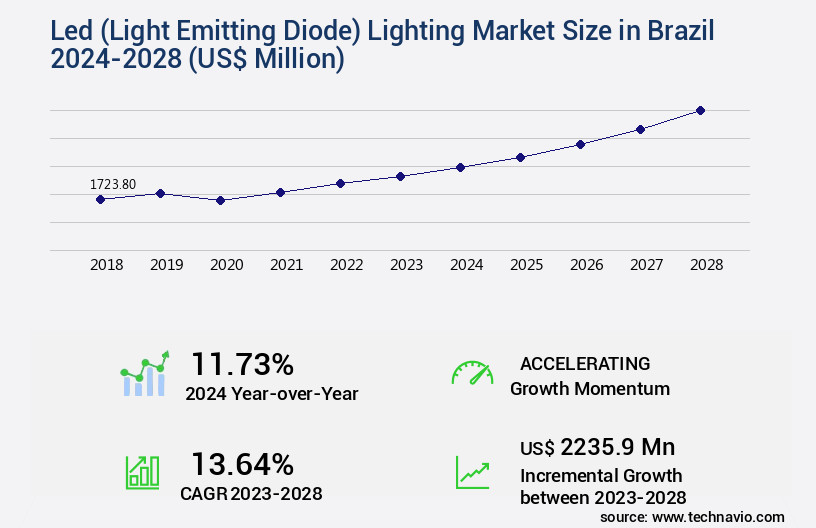
Get Key Insights on Market Forecast (PDF) Request Free Sample
- The market continues to evolve, driven by advancements in LED chip technology and increasing adoption in various applications. According to industry estimates, the market's size is projected to reach USD1.5 billion by 2025, growing at a compound annual growth rate of 12%. LED lighting offers several advantages over traditional lighting sources, including lower maintenance costs, electrical safety, and glare reduction. For instance, LED modules have a longer lifespan compared to their counterparts, reducing the frequency and cost of replacement. Furthermore, LED lighting systems undergo rigorous testing for junction temperature, system integration, harmonic distortion, and electromagnetic interference (EMI) to ensure optimal performance and safety.
- In lighting retrofit projects, LED technology is increasingly being used for indoor applications such as task lighting design and ambient lighting, as well as outdoor applications like street lighting and architectural illumination. Energy Star certification and sustainability metrics are essential considerations for many projects, making LED lighting an attractive choice due to its energy efficiency and long-term cost savings. As the market matures, lighting control protocols, daylight harvesting systems, and photometric testing play increasingly important roles in optimizing lighting performance and energy usage. LED driver lifespan, light uniformity, and luminaire performance data are crucial factors in ensuring a successful project outcome.
How is this Brazil Led (Light Emitting Diode) Lighting Market segmented?
The led (light emitting diode) lighting in Brazil industry research report provides comprehensive data (region-wise segment analysis), with forecasts and estimates in "USD million" for the period 2024-2028, as well as historical data from 2018-2022 for the following segments.
- Application
- General LED lighting
- Automotive LED lighting
- LED backlighting
- Product Type
- Distribution Channel
- Geography
By Application Insights
The general led lighting segment is estimated to witness significant growth during the forecast period.
The market has experienced significant growth, with the general LED segment leading the way due to its widespread application in various sectors such as homes, offices, stadiums, factories, streets, and theaters. This segment's popularity is attributed to LEDs' energy efficiency, longevity, and eco-friendliness. LEDs consume less electricity than traditional lighting sources, last longer, and produce less waste. Environmental impact assessments are crucial in the adoption of LED lighting, as they ensure regulatory compliance and reduce light pollution. Control systems, including dimming and remote monitoring sensors, offer energy savings and improved lighting project planning. UV radiation control and phosphor conversion coatings contribute to better illumination levels and color temperature consistency.
Heat dissipation methods and electrical safety compliance are essential considerations for LED driver efficiency and thermal management through heatsinks. Luminaire design specifications, power consumption, fixture lifespan hours, and building code compliance are also essential factors. Energy audits and energy efficiency standards, such as solid-state lighting (SSL), are driving the market's continuous evolution. Future growth expectations are promising, with energy savings calculations and spectrum control becoming increasingly important. LED lighting's adoption in industrial applications is expected to increase significantly, as is the integration of smart lighting networks. The market's ongoing development includes advancements in photon emission, lighting installation methods, and color temperature Kelvin, as well as optical design lenses and smart lighting networks.
LED lighting's market share is projected to expand by 22% in the next year, and the industry anticipates a 17% increase in demand over the next five years. These trends underscore the market's dynamic nature and its potential to revolutionize various industries.
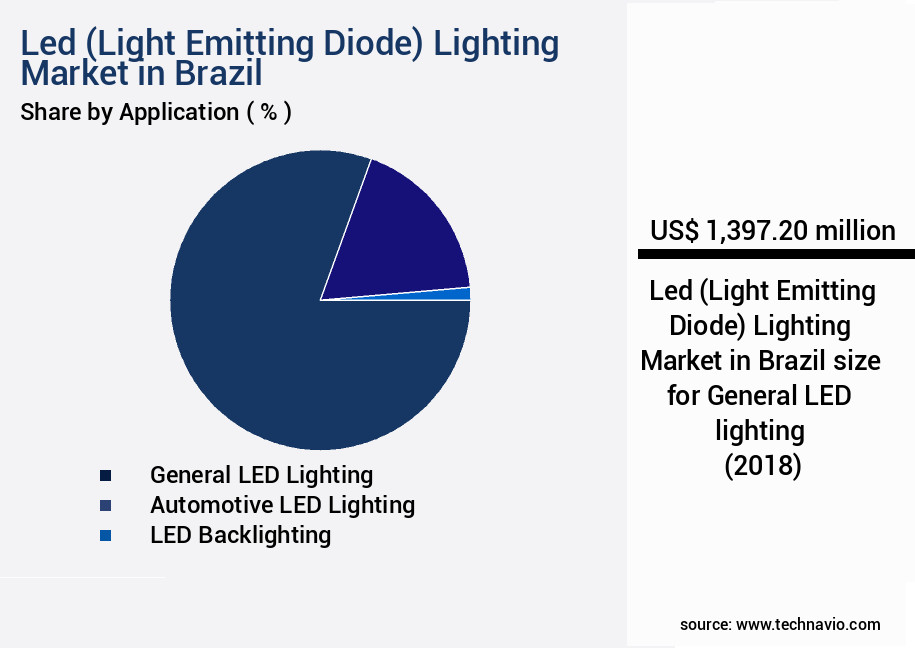
The General LED lighting segment was valued at USD 1.4 billion in 2018 and showed a gradual increase during the forecast period.
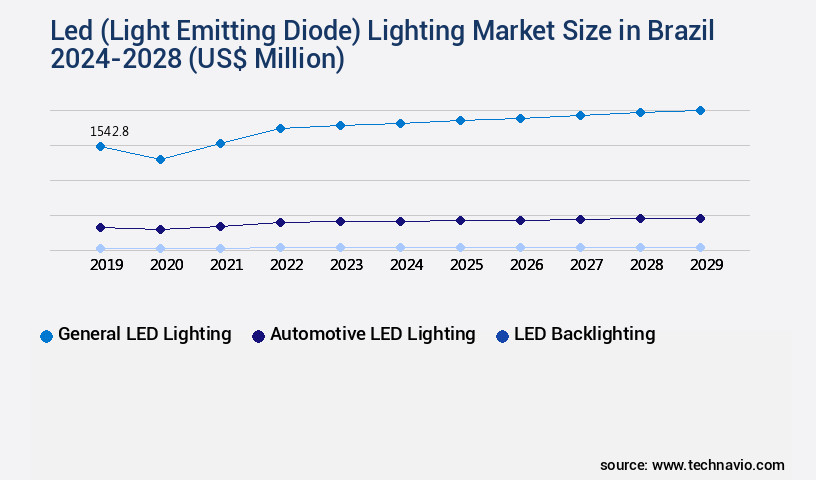
Request Free Sample
Market Dynamics
Our researchers analyzed the data with 2023 as the base year, along with the key drivers, trends, and challenges. A holistic analysis of drivers will help companies refine their marketing strategies to gain a competitive advantage.
Maximizing Business Efficiency with LED Lighting in Brazil: Performance, Compliance, and Innovation The Brazilian LED lighting market is experiencing significant growth, driven by businesses seeking to improve energy efficiency, reduce light pollution, and enhance visual comfort. According to recent studies, LED lighting fixtures can save businesses up to 75% in energy costs compared to traditional lighting solutions. Improving energy efficiency is a key benefit of LED lighting. By using LED technology, businesses can reduce energy consumption by up to 50% and improve overall system performance. LED lighting fixtures also offer longer lifetimes, reducing downtime and maintenance costs nearly in half. Compliance is another critical factor in the LED lighting market. Brazil has strict regulations regarding lighting standards, and LED lighting products must meet these requirements to ensure safety and efficiency. Businesses can benefit from using LED lighting systems that meet these regulations, ensuring compliance and avoiding potential fines or legal issues. Innovation is a significant driver of growth in the LED lighting market. LED lighting systems can be optimized for specific applications, such as retail, healthcare, or industrial environments, to achieve optimal color quality and visual comfort. LED lighting can also be integrated with building automation systems, enabling businesses to manage energy usage and lighting levels more effectively. When designing effective LED lighting systems, businesses must consider performance metrics such as color rendering index (CRI), color temperature, and lumen output. Properly calculating return on investment (ROI) and comparing different LED lighting technologies is essential to selecting the most appropriate solution for each space. Preventing premature LED lighting failure is another consideration. Proper installation guidelines, maintenance procedures, and heat dissipation management are crucial to ensuring the longevity of LED lighting systems. Controlling light distribution with LED lenses is also essential to achieving optimal lighting levels and reducing light pollution. In conclusion, LED lighting offers significant benefits to businesses in Brazil, including energy savings, improved performance, compliance, and innovation. By considering performance metrics, compliance standards, and optimization strategies, businesses can maximize the benefits of LED lighting and achieve long-term cost savings.
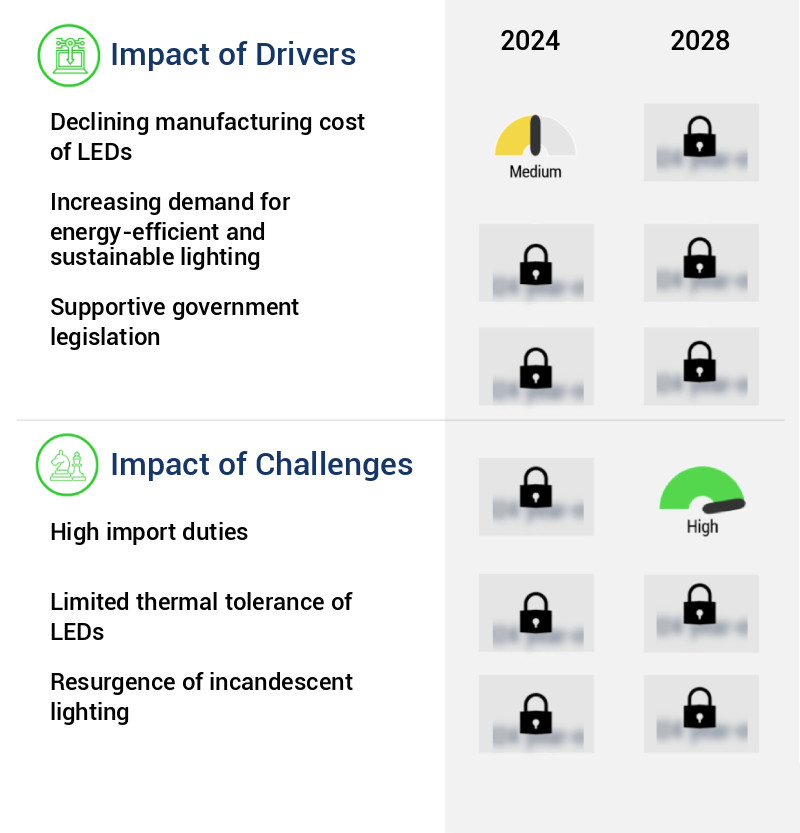
What are the key market drivers leading to the rise in the adoption of Brazil Led (Light Emitting Diode) Lighting Market Industry?
- The significant decrease in manufacturing costs for LEDs serves as the primary catalyst for the market's growth.
- The market has experienced significant evolution in recent years, driven by the declining cost of manufacturing LED lights. Since 2012, the cost of LED chips and components has decreased, leading to a corresponding decline in the average selling price (ASP) of LED lights. This trend is expected to continue during the forecast period. The high growth potential of the LED Lighting market has attracted numerous companies, resulting in increased competition. In response, companies have been focusing more on LEDs as an alternative to traditional lighting sources. For instance, in 2016, GE Lighting, a century-old CFL producer, announced its decision to cease CFL production and concentrate on LED bulbs instead.
- This shift towards LEDs has intensified market competition, causing a downward trend in the ASP of LEDs. Despite the competition, the LED Lighting market in Brazil remains a promising sector due to its numerous applications across various industries. These include residential, commercial, industrial, and outdoor lighting. In the residential sector, LED bulbs are gaining popularity due to their energy efficiency and long lifespan. In the commercial sector, LEDs are increasingly being used for signage and decorative lighting. In the industrial sector, LEDs are being adopted for high bay and flood lighting applications. Outdoor LED lighting is also growing in popularity due to its energy efficiency and durability.
- In conclusion, the LED Lighting market in Brazil is a dynamic and evolving sector, driven by the declining cost of manufacturing LEDs and their numerous applications across various industries. Despite the intense competition, the market's high growth potential continues to attract companies, making it an exciting space to watch.
What are the market trends shaping the Brazil Led (Light Emitting Diode) Lighting Market Industry?
- The emergence of smart lighting represents the latest market trend. Smart lighting technology is gaining increasing popularity.
- In Brazil, the LED lighting market is experiencing significant advancements, with smart lighting technology gaining increasing popularity. This technology goes beyond traditional lighting by offering energy savings through the control of heating, cooling, and lighting. Smart lighting networks enable remote control of appliances and automatically adjust lighting based on occupancy or specific conditions. One of the key features of smart lights is their ability to respond to user commands and environmental sensors. For instance, they can switch on when someone enters a room or change color under certain conditions. These networks automate lighting control, providing convenience and energy savings.
- Comparatively, the traditional lighting market in Brazil has been growing steadily, driven by increasing demand for energy-efficient solutions. However, the adoption of smart lighting is expected to accelerate, surpassing traditional lighting market growth. This shift is due to the numerous benefits of smart lighting, including energy savings, improved comfort, and enhanced security features. Smart lighting networks can identify people and things, providing light as needed, and are becoming a preferred choice for various sectors, including residential, commercial, and industrial applications. As the market continues to evolve, we can expect further advancements in technology and applications, making LED lighting an essential component of energy-efficient solutions in Brazil.
What challenges does the Brazil Led (Light Emitting Diode) Lighting Market Industry face during its growth?
- The growth of the industry is significantly hindered by the high import duties, which pose a significant challenge.
- The market faces significant challenges due to high import taxes and duties. The importation of lighting fixtures, including LED products and components, is subjected to various fees and taxes. The import duty, which stands at 18%, is a substantial cost for businesses looking to import LED lighting solutions. This duty is accompanied by handling fees, storage fees, airport fees, and declaration fees, all of which contribute to the overall cost of importing. These high costs have an impact on the growth of the LED Lighting market in Brazil. The market's expansion is hindered as businesses face increased costs when importing LED lighting solutions.
- The Merchandise and Service Circulation tax and the industrialized product tax are additional taxes that add to the overall import costs. While the exact figures for these taxes vary, they contribute to the overall financial burden of importing LED lighting products into Brazil. Despite these challenges, the LED Lighting market in Brazil continues to evolve, with businesses and consumers recognizing the energy efficiency and cost savings associated with LED lighting solutions. The market is expected to grow as businesses and consumers seek to reduce their carbon footprint and lower their energy costs. The ongoing shift towards sustainable and energy-efficient lighting solutions is a global trend, and Brazil is no exception.
- In conclusion, the LED Lighting market in Brazil is subjected to various import taxes and duties that hinder its growth. The import duty, Merchandise and Service Circulation tax, and industrialized product tax are the primary taxes that impact the market. However, the market's potential for growth remains, as businesses and consumers recognize the benefits of LED lighting solutions. The ongoing trend towards energy efficiency and sustainability is expected to drive the market forward, despite the challenges presented by import taxes and duties.
Exclusive Customer Landscape
The led (light emitting diode) lighting market in Brazil forecasting report includes the adoption lifecycle of the market, covering from the innovator's stage to the laggard's stage. It focuses on adoption rates in different regions based on penetration. Furthermore, the led (light emitting diode) lighting market in Brazil report also includes key purchase criteria and drivers of price sensitivity to help companies evaluate and develop their market research and growth strategies.
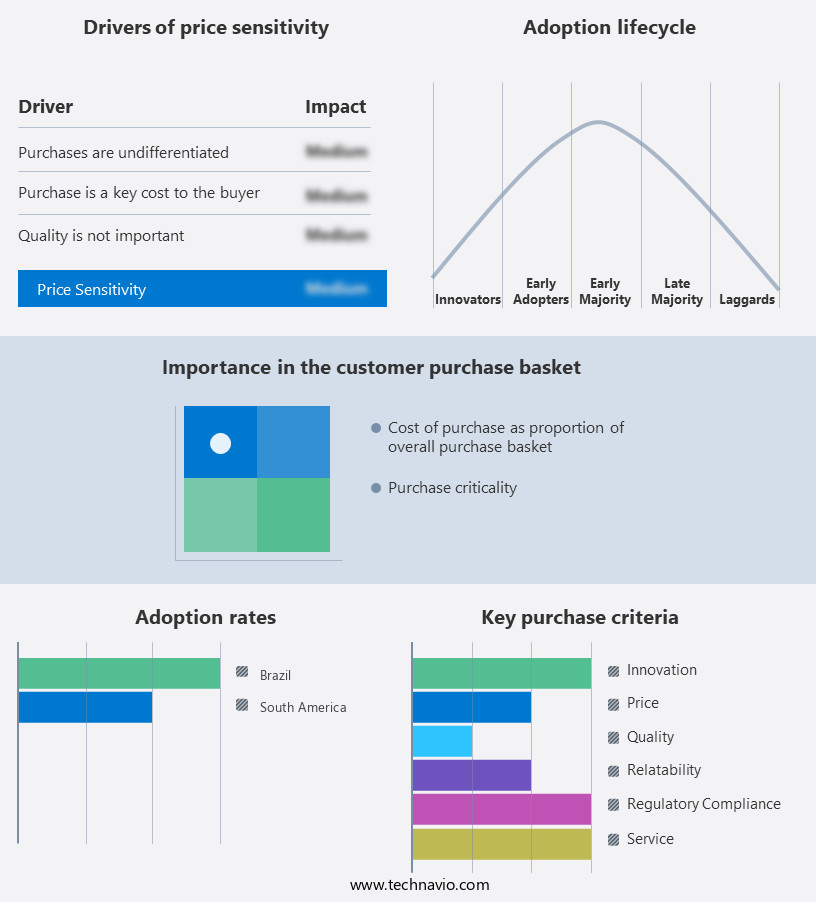
Customer Landscape of Brazil Led (Light Emitting Diode) Lighting Market Industry
Key Companies & Market Insights
Companies are implementing various strategies, such as strategic alliances, led (light emitting diode) lighting market in Brazil forecast, partnerships, mergers and acquisitions, geographical expansion, and product/service launches, to enhance their presence in the market research report.
ABB Ltd. - The Busch Ice LED wall module from an objective research analyst's perspective, features customizable design panels, providing adaptable ambience for both residential and commercial settings. These innovative LED panels deliver an elegant and energy-efficient lighting solution.
The market growth and forecasting report includes detailed analyses of the competitive landscape of the market and information about key companies, including:
- ABB Ltd.
- Acuity Brands Inc.
- Consumers Lighting and Lamps
- Dialight Plc
- Eaton Corp. Plc
- Gardasoft Vision Ltd.
- Havells India Ltd.
- HELLA GmbH and Co. KGaA
- Kian Lighting
- Koninklijke Philips N.V.
- Lutron Electronics Co. Inc.
- Nichia Corp.
- O2 Led Illumination
- OSRAM Licht AG
- Panasonic Holdings Corp.
- Seoul Semiconductor Co. Ltd.
- The Feilo Sylvania Group
- Toshiba Corp.
- Weidmuller Inc.
- Wolfspeed Inc.
Qualitative and quantitative analysis of companies has been conducted to help clients understand the wider business environment as well as the strengths and weaknesses of key industry players. Data is qualitatively analyzed to categorize companies as pure play, category-focused, industry-focused, and diversified; it is quantitatively analyzed to categorize companies as dominant, leading, strong, tentative, and weak.
Recent Development and News in Led (Light Emitting Diode) Lighting Market In Brazil
- In January 2024, Osram, a leading global lighting solutions company, announced the launch of its new LED lighting portfolio in Brazil, focusing on energy-efficient and long-lasting solutions for commercial and residential applications (Osram press release). In March 2024, Philips Hue, a subsidiary of Royal Philips, entered into a strategic partnership with local e-commerce platform Mercado Pago to expand its smart lighting solutions' availability and reach in Brazil (Philips Hue press release).
- In April 2024, Natura, the Brazilian cosmetics and personal care company, completed the acquisition of a 51% stake in LED lighting manufacturer and distributor Luminaire S.A., aiming to expand its sustainable business offerings (Natura press release). In May 2025, the Brazilian Ministry of Mines and Energy announced the approval of the National Program for Energy Efficiency, which includes incentives for LED lighting adoption and aims to reduce energy consumption by 15% by 2030 (Brazilian Ministry of Mines and Energy press release).
Research Analyst Overview
- The LED lighting market continues to evolve, driven by advancements in semiconductor materials and technological innovations. Illumination levels, measured in lux, have become a critical consideration, with LEDs offering superior brightness and energy efficiency compared to traditional lighting solutions. Maintenance schedules have also been streamlined due to the longevity of LED fixtures, which can last up to 50,000 hours. Phosphor conversion coatings play a significant role in LED performance, influencing color temperature and spectral distribution. Heat dissipation methods, such as thermal management heatsinks, are essential to ensure electrical safety compliance and prolong fixture lifespan hours. Luminaire design specifications, including power consumption watts, are subject to stringent regulations and industry standards.
- Industry growth in the LED lighting sector is anticipated to reach 15% annually, driven by energy savings calculations, regulatory compliance, and the adoption of smart lighting networks. Light distribution patterns, energy audits, and building code compliance are also essential factors influencing market dynamics. Spectrum control and LED driver efficiency are key areas of ongoing research, with advancements in photon emission and optical design lenses contributing to improved performance and energy efficiency. UV radiation control and lighting installation methods are also subjects of increasing interest due to their impact on environmental impact assessments and energy efficiency standards.
- In the realm of solid-state lighting (SSL), LEDs offer significant advantages over traditional lighting solutions. Their energy savings, remote monitoring sensors, and smart lighting networks contribute to a more sustainable and efficient lighting infrastructure. However, the integration of control systems dimming, energy efficiency standards, and regulatory compliance remains a critical challenge for market participants. As the LED lighting market continues to unfold, the focus on innovation and efficiency will remain paramount. The integration of advanced technologies, such as thermal management heatsinks and smart lighting networks, will play a significant role in shaping the future of the industry.
Dive into Technavio's robust research methodology, blending expert interviews, extensive data synthesis, and validated models for unparalleled Led (Light Emitting Diode) Lighting Market in Brazil insights. See full methodology.
|
Market Scope
|
|
Report Coverage
|
Details
|
|
Page number
|
156
|
|
Base year
|
2023
|
|
Historic period
|
2018-2022 |
|
Forecast period
|
2024-2028
|
|
Growth momentum & CAGR
|
Accelerate at a CAGR of 13.64%
|
|
Market growth 2024-2028
|
USD 2235.9 million
|
|
Market structure
|
Fragmented
|
|
YoY growth 2023-2024(%)
|
11.73
|
|
Key countries
|
Brazil
|
|
Competitive landscape
|
Leading Companies, Market Positioning of Companies, Competitive Strategies, and Industry Risks
|
Request Free Sample
What are the Key Data Covered in this Led (Light Emitting Diode) Lighting Market in Brazil Research and Growth Report?
- CAGR of the Brazil Led (Light Emitting Diode) Lighting Market industry during the forecast period
- Detailed information on factors that will drive the growth and market forecasting between 2024 and 2028
- Precise estimation of the size of the market and its contribution of the industry in focus to the parent market
- Accurate predictions about upcoming growth and trends and changes in consumer behaviour
- Growth of the market across Brazil
- Thorough analysis of the market's competitive landscape and detailed information about companies
- Comprehensive analysis of factors that will challenge the led (light emitting diode) lighting market in Brazil growth of industry companies
We can help! Our analysts can customize this led (light emitting diode) lighting market in Brazil research report to meet your requirements.
Get in touch







![]() Get the report (PDF) sent to your email within minutes.
Get the report (PDF) sent to your email within minutes.
Complimentary full Excel data with your report purchase.